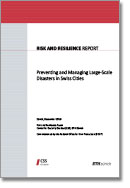Preventing and Managing Large-Scale Disasters in Swiss Cities

Author(s): Tim Prior, Florian Roth, Linda Maduz
Series: Risk and Resilience Reports
Publisher(s): Center for Security Studies (CSS), ETH Zurich
Publication Year: 2016
